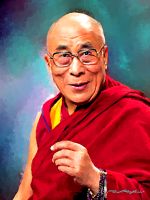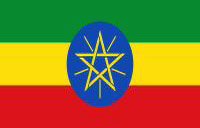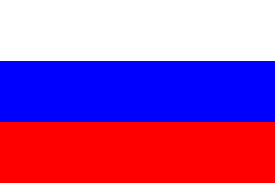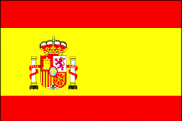
The 14th Dalai Lama
The Nobel Peace Prize 1989
Religious and Political Leader of Tibet
Head of nonviolent opposition to China's occupation of Tibet.
"Human happiness and human satisfaction must ultimately come from within oneself."
Longer biography, New York Times.
Biography
Generously contributed by The 14th Dalai Lama
Education in Tibet
Leadership Responsibilities
Democratization Process
Peace Initiatives
Universal Recognition
Political Retirement
The Future
His Holiness the 14th Dalai Lama, Tenzin Gyatso, describes himself as a simple Buddhist monk. He is the spiritual leader of Tibet. He was born on 6 July 1935, to a farming family, in a small hamlet located in Taktser, Amdo, northeastern Tibet. At the very young age of two, the child who was named Lhamo Dhondup at that time, was recognized as the reincarnation of the previous 13th Dalai Lama, Thubten Gyatso.
The Dalai Lamas are believed to be manifestations of Avalokiteshvara or Chenrezig, the Bodhisattva of Compassion and the patron saint of Tibet. Bodhisattvas are believed to be enlightened beings who have postponed their own nirvana and chosen to take rebirth in order to serve humanity.
Education in Tibet
His Holiness began his monastic education at the age of six. The curriculum consisted of five major and five minor subjects. The major subjects were logic, Tibetan art and culture, Sanskrit, medicine, and Buddhist philosophy which was further divided into a further five categories: Prajnaparimita, the perfection of wisdom; Madhyamika, the philosophy of the middle Way; Vinaya, the canon of monastic discipline; Abidharma, metaphysics; and Pramana, logic and epistemology. The five minor subjects were poetry, music and drama, astrology, composition and phrasing, and synonyms. At 23, His Holiness sat for his final examination in Lhasa's Jokhang Temple, during the annual Monlam (prayer) Festival in 1959. He passed with honors and was awarded the Geshe Lharampa degree, the highest-level degree, equivalent to a doctorate of Buddhist philosophy.
Leadership Responsibilities
In 1950 His Holiness was called upon to assume full political power after China's invasion of Tibet in 1949/50. In 1954, he went to Beijing for peace talks with Mao Zedong and other Chinese leaders, including Deng Xiaoping and Chou Enlai. But finally, in 1959, with the brutal suppression of the Tibetan national uprising in Lhasa by Chinese troops, His Holiness was forced to escape into exile. Since then he has been living in Dharamsala, northern India.
Since the Chinese invasion, the Central Tibetan Administration led by His Holiness appealed to the United Nations on the question of Tibet. The General Assembly adopted three resolutions on Tibet in 1959, 1961 and 1965.
Democratization Process
In 1963, His Holiness presented a draft democratic constitution for Tibet that was followed by a number of reforms to democratize the Tibetan administrative set-up. The new democratic constitution promulgated as a result of this reform was named "The Charter of Tibetans in Exile". The charter enshrines freedom of speech, belief, assembly and movement. It also provides detailed guidelines on the functioning of the Tibetan Administration with respect to those living in exile.
In 1992, the Central Tibetan Administration issued guidelines for the constitution of a future, free Tibet. The guidelines outlined that when Tibet became free the immediate task would be to set up an interim government whose first responsibility will be to elect a constitutional assembly to frame and adopt Tibet's democratic constitution. His Holiness also stated that he hoped that Tibet, comprising of the three traditional provinces of U-Tsang, Amdo and Kham, would be federal and democratic.
In May 1990, the reforms called for by His Holiness saw the realization of a truly democratic administration in exile for the Tibetan community. The Tibetan Cabinet (Kashag), which till then had been appointed by His Holiness, was dissolved along with the Tenth Assembly of the Tibetan People's Deputies (Tibetan parliament in exile). In the same year, exile Tibetans on the Indian sub-continent and in more than 33 other countries elected 46 members to the expanded Eleventh Tibetan Assembly on a one-man one-vote basis. The Assembly, in its turn, elected the new members of the cabinet.
In September 2001, a further major step in democratization was taken when the Tibetan electorate directly elected the Kalon Tripa, the senior-most minister of the Cabinet. The Kalon Tripa in turn appointed his own cabinet who had to be approved by the Tibetan Assembly. In Tibet's long history, this was the first time that the people elected the political leadership of Tibet. Since the direct election of the Kalon Tripa, the system of the institution of Gaden Phodrang of the Dalai Lama as both the spiritual and temporal authority ended. Since then, His Holiness described himself as being semi-retired.
Peace Initiatives
On 21 September 1987 in his address to members of the United States Congress in Washington, DC, His Holiness proposed a Five-Point Peace Plan for Tibet as the first step towards a peaceful solution to the worsening situation in Tibet. The peace plan contained five basic components:
- Transformation of the whole of Tibet into a zone of peace.
- Abandonment of China's population transfer policy that threatens the very existence of the Tibetans as a people.
- Respect for the Tibetan people's fundamental human rights and democratic freedoms.
- Restoration and protection of Tibet's natural environment and the abandonment of China's use of Tibet for the production of nuclear weapons and dumping of nuclear waste.
- Commencement of earnest negotiations on the future status of Tibet and of relations between the Tibetan and Chinese peoples.
On 15 June 1988 in an address to members of the European Parliament in Strasbourg, His Holiness made another detailed proposal elaborating on the last point of the Five-Point Peace Plan. He proposed talks between the Chinese and Tibetans leading to a self-governing democratic political entity for all three provinces of Tibet. This entity would be in association with the People's Republic of China and the Chinese Government would continue to remain responsible for Tibet's foreign policy and defence.
Universal Recognition
His Holiness the Dalai Lama is a man of peace. In 1989 he was awarded the Nobel Peace Prize for his non-violent struggle for the liberation of Tibet. He has consistently advocated policies of non-violence, even in the face of extreme aggression. He also became the first Nobel Laureate to be recognized for his concern for global environmental problems.
His Holiness has travelled to more than 67 countries spanning 6 continents. He has received over 150 awards, honorary doctorates, prizes, etc., in recognition of his message of peace, non-violence, inter-religious understanding, universal responsibility and compassion. He has also authored or co-authored more than 110 books.
His Holiness has held dialogues with heads of different religions and participated in many events promoting inter-religious harmony and understanding.
Since the mid-1980's, His Holiness has begun a dialogue with modern scientists, mainly in the fields of psychology, neurobiology, quantum physics and cosmology. This has led to a historic collaboration between Buddhist monks and world-renowned scientists in trying to help individuals achieve peace of mind. This has also led to the introduction of modern science in the traditional curriculum of Tibetan monastic institutions re-established in exile.
Political Retirement
On 14 March 2011 His Holiness sent a letter to the Assembly of Tibetan People's Deputies (Tibetan Parliament in exile) requesting them to devolve him of his temporal (political) power. According to The Charter of the Tibetans in Exile, His Holiness was technically still considered to be the head of state. The historic announcement would bring an end to the dual spiritual and political authority of the Dalai Lama and revert to the previous tradition of the first four Dalai Lamas being only the spiritual leader of Tibet. The democratically elected leadership would assume complete formal political leadership of Tibet. The Ganden Phodrang, the institution of the Dalai Lamas, would continue and remain intact.
On 29 May 2011 His Holiness signed into law the formal transfer of his temporal power to the democratically elected leader. This brought to an end the 368-year old tradition of the Dalai Lamas being both spiritual and temporal head of Tibet.
The Future
As far back as 1969, His Holiness has made clear that concerned people should decide whether the Dalai Lama's reincarnations should continue in the future. However, in the absence of clear guidelines, should the concerned public express a strong wish for the Dalai Lamas to continue, there is an obvious risk of vested political interests misusing the reincarnation system to fulfill their own political agenda. Therefore, on 24 September 2011, clear guidelines were drawn up to recognize the next Dalai Lama, so that there is no room for doubt or deception.
His Holiness has stated that when he is about ninety he will consult the high Lamas of the Tibetan Buddhist traditions, the Tibetan public, and other concerned people who follow Tibetan Buddhism, and re-evaluate whether the institution of the Dalai Lama should continue or not. On that basis, a decision will be made. If it is decided that the reincarnation of the Dalai Lama should continue and there is a need for the Fifteenth Dalai Lama to be recognized, responsibility for doing so will primarily rest on the concerned officers of the Dalai Lama's Gaden Phodrang Trust. They should consult the various heads of the Tibetan Buddhist traditions and the reliable oath-bound Dharma Protectors who are linked inseparably to the lineage of the Dalai Lamas. They should seek advice and direction from these concerned beings and carry out the procedures of search and recognition in accordance with past tradition. His Holiness would leave clear written instructions about this. Bear in mind that, apart from the reincarnation recognized through such legitimate methods, no recognition or acceptance should be given to a candidate chosen for political ends by anyone, including those in the People's Republic of China.
Discover Your Abilities and Aspirations!
 $10 $25 $50 $100 Other
$10 $25 $50 $100 Other
Tax Exempt 501(c)3 Non-Profit Organization
Any Currency
“…the peace that is found in libraries and laboratories…” - Louis Pasteur
Copyright © 2023 Ganga Library Inc. All Rights reserved.;

Photo: Christopher Michel. Painting: Tim Tompkins PaintHistory.com
Name: The 14th Dalai Lama
Birth: 6 July 1935, Taktser, Tibet (now occupied by People's Republic of China)
Residence when prize awarded: India
Award: Advocate for Peace and Freedom
Subject: human rights
Biography
Chronology of Events
Books
External Links [Mainly Text]
His Holiness The 14th Dalai Lama of Tibet
Videos













